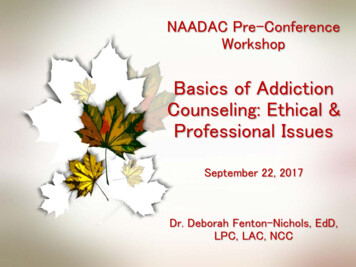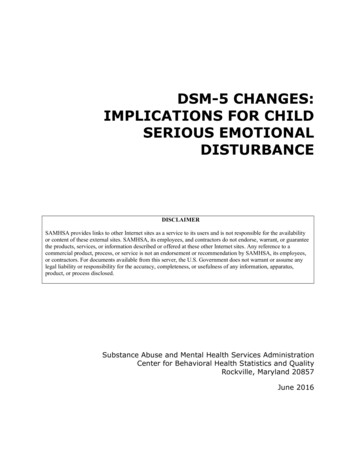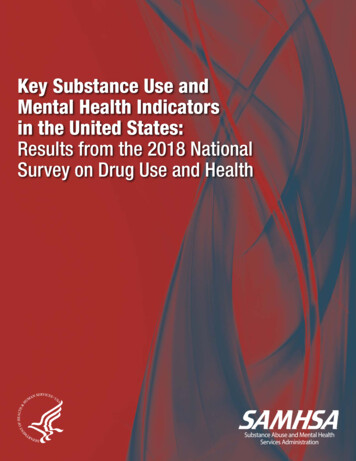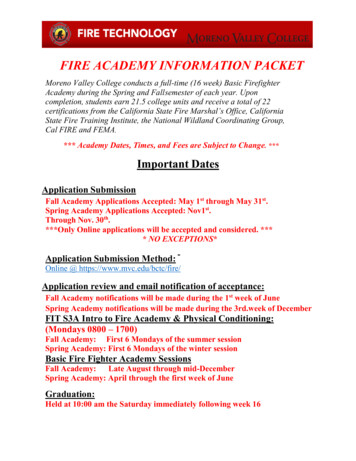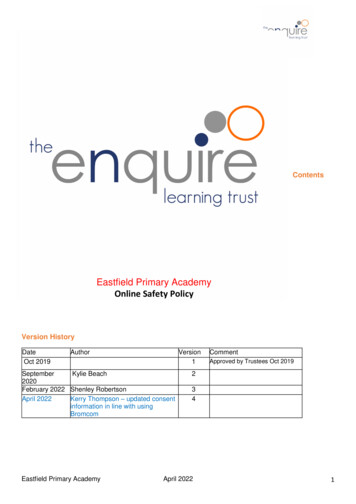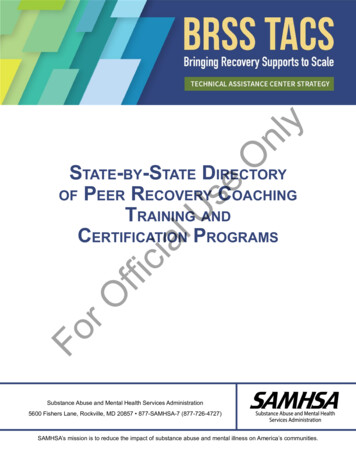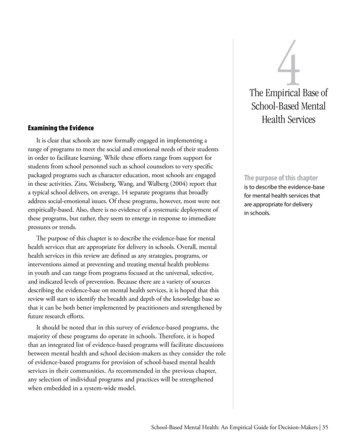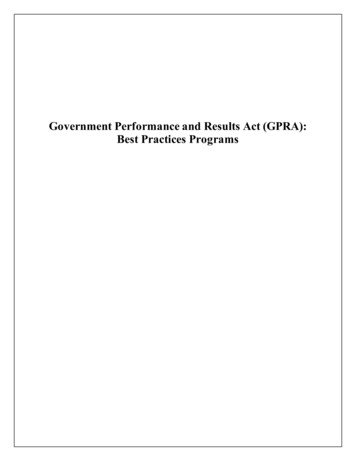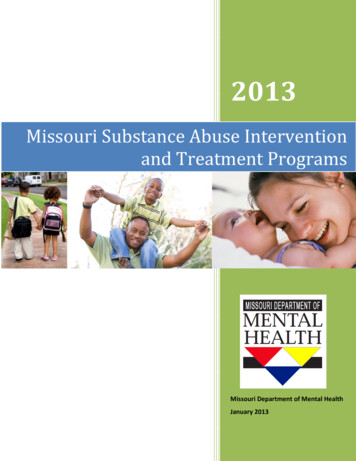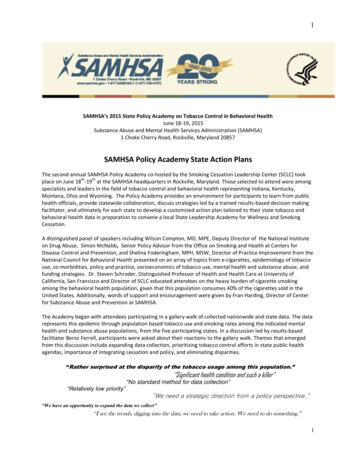
Transcription
1SAMHSA’s 2015 State Policy Academy on Tobacco Control in Behavioral HealthJune 18-19, 2015Substance Abuse and Mental Health Services Administration (SAMHSA)1 Choke Cherry Road, Rockville, Maryland 20857SAMHSA Policy Academy State Action PlansThe second annual SAMHSA Policy Academy co-hosted by the Smoking Cessation Leadership Center (SCLC) tookththplace on June 18 -19 at the SAMHSA headquarters in Rockville, Maryland. Those selected to attend were amongspecialists and leaders in the field of tobacco control and behavioral health representing Indiana, Kentucky,Montana, Ohio and Wyoming. The Policy Academy provides an environment for participants to learn from publichealth officials, provide statewide collaboration, discuss strategies led by a trained results-based decision makingfacilitator, and ultimately for each state to develop a customized action plan tailored to their state tobacco andbehavioral health data in preparation to convene a local State Leadership Academy for Wellness and SmokingCessation.A distinguished panel of speakers including Wilson Compton, MD, MPE, Deputy Director of the National Instituteon Drug Abuse, Simon McNabb, Senior Policy Advisor from the Office on Smoking and Health at Centers forDisease Control and Prevention, and Shelina Foderingham, MPH, MSW, Director of Practice Improvement from theNational Council for Behavioral Health presented on an array of topics from e-cigarettes, epidemiology of tobaccouse, co-morbidities, policy and practice, socioeconomics of tobacco use, mental health and substance abuse, andfunding strategies. Dr. Steven Schroder, Distinguished Professor of Health and Health Care at University ofCalifornia, San Francisco and Director of SCLC educated attendees on the heavy burden of cigarette smokingamong the behavioral health population, given that this population consumes 40% of the cigarettes sold in theUnited States. Additionally, words of support and encouragement were given by Fran Harding, Director of Centerfor Substance Abuse and Prevention at SAMHSA.The Academy began with attendees participating in a gallery walk of collected nationwide and state data. The datarepresents this epidemic through population based tobacco use and smoking rates among the indicated mentalhealth and substance abuse populations, from the five participating states. In a discussion led by results-basedfacilitator Beroz Ferrell, participants were asked about their reactions to the gallery walk. Themes that emergedfrom this discussion include expanding data collection, prioritizing tobacco control efforts in state public healthagendas, importance of integrating cessation and policy, and eliminating disparities.“Rather surprised at the disparity of the tobacco usage among this population.”“Significant health condition and such a killer”“No standard method for data collection”“Relatively low priority”“We need a strategic direction from a policy perspective.”“We have an opportunity to expand the data we collect”“I see the trends, digging into the data, we need to take action. We need to do something.”1
2The following document captures the collaborative work from the five states and isintended to be a preliminary tool to help launch each state’s summit.Meeting Purpose: To learn about the epidemic of tobacco use and behavioral health and whatworks to reduce the prevalence To understand the statewide collaborative process to address tobacco use bythose with mental health and substance use disorders To prepare states to convene a potential local State Leadership Academy forWellness and Smoking CessationMeeting Results:By the end of the Academy the participants: Understood their roles in implementing a successful local effort Identified and agreed upon a proposed state baseline and target to inform thedirection of the state efforts Created a draft invitation list of committed partners to leverage statewide effortsIndiana Action Plan. (Pages 3-6)Kentucky Action Plan . . (Pages 7-9)Montana Action Plan . (Pages 10-12)Ohio Action Plan . . (Pages 13-15)Wyoming Action Plan (Pages 16-18)Conclusion . (Page 19)Check Out (Action Commitments) . . . (Page 20)2
3IndianaWhat Other Data Points Might Your State Need for Tobacco Use byBehavioral Health Populations?Type of dataFQHC’s patientand providertobaccodependencetreatment data% quitline callersreporting BHsymptomsPossible data sourcesState FQHC’s have to collect this information. HRSA offers this online.Click on link to see the 3 FQHC’s in Indiana and details on populationand ?year 2013&state IN#glist)Contact/LeadCatherine SaucedoState quitline offers these intake questions:1. Do you have any mental health issues or emotionalchallenges, such as an anxiety disorder, depression disorder,bipolar disorder, alcohol/drug abuse, or schizophrenia?2. Do you believe that these mental health issues or emotionalchallenges will interfere with your ability to quit?Miranda SpitznagleCancer dataGeneralPopulationCounty CMHC’stobaccocessationServicesTobacco Policyand cessationservicesinformationfrom Statefunded CMHCentersYouth tobaccouse dataGeneral Statetobacco useprevalence dataand Behavioralhealth tobaccouse dataState Cancer RegistryState Epidemiological ReportKatherine CrawfordKim ManloveState contract treatment service center – SAMHSA has an applicationfor funding to states to collect data from CCBHCsShelina Foderinghamwill connect w/Miranda SpitznagleTobacco Control will be surveying the state funded Community mentalhealth centers this year to see who is enforcing existing tobacco-freepolicy and providing services to assess gaps and areas to help supportthe centers with TA.Miranda SpitznagleYRBSDennis AilesBRFSSDennis Ailes3
4Where are we now?Proposed Baseline (Mental Health)Data Source42.0%(current smokers with frequent poor mental Health Days)BRFSS * choose this source because it is more reliable,can gain access and control reporting easierProposed Baseline (Substance Abuse)Data Source36.2%(current smokers who reported binge drinking at least once in thepast 30 days; men having 5 or more drinks on one occasion,women having 4 or more drinks on one occasion)BRFSS* choose this source because it is more reliable,can gain access and control reporting easier*find out more about alternative sources that represent both sectors more thoroughly and consider flipping % like KentuckyWhere do we want to be?Proposed Target (Mental Health)Reduce smoking rates by 18% in the MH population by 2020 (42.0%-35.0%).Proposed Target (Substance Abuse)Reduce smoking rates by 18% in the SA population by 2020 (36.2%-30.0%).How will we get there?If you are to achieve your target, how can your planning team members work together to impact the system ?Work with Department of Corrections – integrate tobacco dependence treatment (inside and outside) facility intoan existing continuity of care model specifically for addictions - Joan DuwveMonitor contracts more frequently around policy and practice at behavioral health facilities. Work with TobControl to identify ways to improve cessation services and enforcement tactics– Dennis Ailes & MirandaSpitznagleWork with Insurers around coverage – Get Anthem, subsequent insurers as well as Managed Care to offer ACArecommended coverage. Promote the message that all insurance companies should offer ACA recommendedtobacco coverage. Reference ALA ACA insurance report - Katherine Crawford & JoanEducate primary care docs at FQHCs – Use ACS primary care staff trainers on cancer screening - connect withTobacco Control to help integrate brief intervention, AAR, into existing ACS training. Katherine and MirandaTobacco Tax – Work with Hoosiers for Healthy Indiana coalition (members here are represented) Invite morestakeholders; educate more stakeholders at steering committee with ACS to strengthen support. Katherine,Miranda, Kim ManloveFocus on Tobacco at upcoming Drug Symposium - Ask Wilson Compton to put a plug into SBIRT at the next stateprescription drug abuse symposium and get a spot for Miranda Spitznagle to speak as well– JoanRecovery coaching –provide resources needed to integrate tobacco into existing training of 150 coaches – KimManlove, Joan, MirandaIntroduce tobacco cessation information into MAT (medication assistance treatment) – usually refers tomethadone etc. but NRTs can apply too - JoanPromote peer support recovery groups like Nicotine Anonymous–currently AA groups are reporting less and lesssmoking on a national level with 500 non-smoking meetings in AA. It isn’t stopping a problem. It is a not starting4
5problem. Tobacco Control and DMH can promote NA as a peer recovery resource statewide – Miranda, DennisMental health provider training – Miranda and Joan explore how to work with Dennis AilesWork with local pharmacy chain to include NRT voucher if they call the quitline - MirandaMethadone Clinics – recommend SAMHSA include tobacco as part of existing policy to offer smoking cessationand/or work with States to do this - JoanMobilizing Your State – Who Can Make This Happen?Comprehensive list of potential partnersName and/or positionNAMI Chapter PresidentMedia contactsEd Clare(HHS House of Rep), PatMiller (HHS Senate)State DirectorLeaders from large county andstate parishesFederal Regional RepresentativesPresidents from NAMI, MHA,AA/NA, Cancer peer supportchapterDirector Developmental DisabilitiesInstituteCasinosDept. of Corrections, DirectorCounty Jails, Director MH servicesPrevention SpecialistDirector, Community Clinics orHRSA connectionIndianapolis employers forumPharmacies, CVS, Target,Independent Pharm, GiantEagle/Kroegers, Walgreens, Eli LilyPediatrics, Family practice, PsychNurses, Psych Pharma.Primary Care association,Pharmacists Alliance, ALA, IHA, PCAssociation, National Council forCommunity behavioral healthChapter for NCAD, NASADAD,Faces and Voices of Recovery,Depression bipolar support allianceKaren Hudmon, Simon – CancerCenter, Arden Christian, IUFSPH,IUPRC, Purdue, Purdue Extension,Sector / Agency / DepartmentLocal/state NAMI chapter or peersupport groupMedia (local paper, news, online/TV)LegislatorsPerson who will make initialinviteMiranda, DennisKatherineDept. Mental Health and/or AddictionsFaith-based organizationMiranda, DennisSAMHSA, HRSA, CDCPeer organizationsCatherine, MirandaDevelopmental DisabilitiesGamingJustice-involved/IncarceratedVA (each hospital has a preventionspecialist)Community clinics / FQHCsBenefits for EmployersRetailers and Large EmployersHC Providers and Association chapterleadsCatherineCatherine can help group connectwith chapter liaison for AmericanPsych Nurses AssociationMH/Addictions AssociationsUniversities/Community Colleges5
6Community College health CenterAssociationOMPD, DOC, IJDHColts player for addictionpreventionMedicaid and other state agenciesAnthem etc., Indiana PhilanthropicAlliance, United Way Indiana,Indiana Healthcare Foundation(Heather Reed)Floyd Memorial Hospital, RonaldKronNFL, MLB, NBA, NCCA, etc.State AgenciesAthletic TeamsState Insurance AgenciesHealth/Family FoundationsHospitalsAthletic Associations (college andprofessional)Next Steps to Implement in Your StateNext stepChoose date for a 15-20 personsummitHave a planning meeting todebrief and set priorities. Meetingcan be in person at IndianaAddictions Coalition Office and viaphoneCreate timelineID additional 2-3 members whocan help move from talk to actionto join a steering committee(prioritize members based onstrategy buckets)Invite steering committeeHost first steering committeeBy when?Spring 2016Contact/Lead/WhoAll of the planning teamJuly 31, 2015Miranda/Kim to coordinate –current planning team toparticipateJuly 31, 2015July 31, 2015All of planning teamAll of planning teamAugust 31, 2015September 30, 2015All of planning teamAll of planning teamIndiana’s ReflectionsWhat is an overnight reflection you had?Goal orientedConnectedThink outside of the soft packFeeling supportedTipping pointEncouraging and inspiringI have hopeIntegration6
7KentuckyWhat Other Data Points Might Your State Need for Tobacco Use byBehavioral Health Populations?Type of dataDisparate populations: Appalachian population (viacounty level data)Low SESWhy people smokeTobacco use and mental illness by county% of Medicaid members using tobacco cessationbenefitsImpact of health department cuts on cessation servicesBH/Quitline dataPossible data sourcesUniversity of Kentucky GIS dept.KY MedicaidNational Jewish HealthWhere are we now?Proposed Baseline (Mental Health)Data Source42.6%(Poor Mental Health)BRFSSProposed Baseline (Substance Abuse)Data Source45.1%(Binge Drinking)BRFSSWhere do we want to be?Proposed Target (Mental Health)Reduce smoking rates by 20% in the MH population by 2020 (42.6% to 34.0%).Proposed Target (Substance Abuse)Reduce smoking rates by 20% in the SA population by 2020 (45.1% to 36.0%).7
8How will we get there?If you are to achieve your target, how can your planning team members work together to impact the system?Prioritize smoking cessation among Medicaid/Mental Health and Substance Use departmentsCraft position statement supporting tobacco-free policies; signed by BH, SA, Medicaid departments, and others;Secretary Audrey Tayse Haines; Commissioner BegleyData collection – conduct focus groups on why people smoke; women and substance abuseContract with quitline to educate MCOsNAMI conference in LouisvilleRegional Prevention Centers/BH directors educationComp care contracts – include incentives for smoking cessation services (or language supporting services)Collect smoking status of Comp Care patientsGet smoking on the agenda in other public agencies(Bring information from Tobacco Cessation Affinity Group to this group)Establish direct referrals to quitline from EHRNRT on Rx pads for providersPromote cessation within CMHC staff “Quit and Win”; motivator for consumersMCO incentives for patients with SPMIMobilizing Your State – Who Can Make This Happen?Comprehensive list of potential partnersSector / Agency / DepartmentMedicaidSmoke-free KYPathways/CMHCsDBHDIDPublic HealthAmerican Lung/Cancer/Heart – reps on Smoke-free coalitionsFoundation for Healthy KentuckyCampaign for TFK- Amy BarkleyState Insurance - KEAPNAMI - KYState HospitalsNurses/Medical AssociationKentucky Public Health AssociationKCC – Kentucky Cancer ConsortiumKCP – Kentucky Cancer ProgramCenter for Rural HealthPrivate Hospitals – The RidgeKentucky Behavioral Health AssociationKARP – Kentucky association for Regional Programs (CMHCS)EQRO – external quality review organization (for Medicaid)PAR – People advocating for Recovery- Mike BerryDept. of EducationDept. of Health Policy- Emily ParentoOmbudsmen OfficeProtection PermancyAnthem8
9Coal Industry/Unions – who influences in Eastern KY?Mental Health AmericaUnited Steel Workers of AmericaOSHAUKY researchersP & A – Protection and AdvocacyKY QuitlineFamily Resource CentersComp CareKY partnership for families and childrenState recovery centersFaith-basedHomeless shelters and soup kitchensUniv. of LoiusvilleNext Steps to Implement in Your StateNext stepCollect and share dataSend data requests to Judy andBobbyEngage leadership; commissionersfrom DBHDID/DPH/DMSPlanning Team Conf. Call / DebriefPrioritize List of Invitees andIdentify contact personDevelop fact sheets and messagingBy when?August 2015July 2015July 2015First week of July 2015Contact/LeadJudy and BobbyeAmy, Ron, WendyWendy and Judy (Medicaid/DMS),Bobbye (DPH-Mayfield)WendyAmandaKentucky’s ReflectionsWhat is an overnight reflection you had?Amicable to my workReal vable9
10MontanaWhere are we now?Proposed Baseline (Mental Health)Data Source48.0%(People with serious psychological distress who useany form of tobacco)State Adult Tobacco SurveyProposed Baseline (Substance Abuse)Data Source31.0%(Addictions/Binge Drinking)BRFSSWhere do we want to be?Proposed Target (Mental Health)Reduce smoking rates by 15% in the MH population by 2020 (48.0% to 41.0%).Proposed Target (Substance Abuse)Reduce smoking rates by 15% in the SA population by 2020 (31.0%-27.0%).How will we get there?If you are to achieve your target, how can your planning team members work together to impact the system?Create interdepartmental workgroupAnalysis of survey dataProvider educationDevelopment of talking points with signatures with endorsements (from leaders to providers)Influence DPHHS DirectorMessagingGood valueWho are we “selling” and what are we saying, making the case, ROIWhat will promote the change? Going from knowledge to action (what are the barriers)?More carrotsDefine obstacles and develop broad planUse the word “workgroup”Planning team to reach out to contacts/network, e.g. Greg to MT medical society – informal outreach, identifypartnershipsTailor surveyInfluence attitudes and knowledgeWhat NRT is covered?Identify barriersPharmacy (pilot) with quitlines10
11Mobilizing Your State – Who Can Make This Happen?Comprehensive list of potential partnersSector / Agency / DepartmentMedical providers – public and private sectors, MDs, NPs, PAs , whole office, administrators, etc.Medical support, ancillary – public and private sectors, RNs, CTTs, MAs, CNAsInpatient and outpatient BH providers – LACs, LCSWs, LCPC, SW, case managers, psychiatrists, psychologists,IHSHospital associationMH adminAddictions adminMT primary care associations to outreach to FQHCsMedicaidMT medical associationNAMI MT, peers, peer support networkCorrectionsWICVAFort HarrisonState psych hospitalsUniversities – MSU U of MT – campus MHAmerican IndiansPrivate insurance – BC/BSOPIDisability servicesBrain injury allianceAmerican Cancer Society/ALA/ etc.Shodair HospitalNext Steps to Implement in Your StateNext stepCreate one pager for potentialstakeholdersBy when?In 2 weeks by end of June 2015Create cheat sheet for planningcommittee (Qs for stakeholders)By Friday June 26, 2015Set up conference call to discussone pager and cheat sheet andmake assignment of who eachplanning team member will talk toSchedule stakeholders meetingsSet in person team meeting datepost stakeholders meetingsSet up invitees listPrioritize next 3 months’actionsJuly 15, 2015, 3 pm MTUp to each team memberAug 27, 1-3 pmContact/LeadClarePlanning team to give input toClare to add to one pagerClare,Planning team/Bobbi to give inputto ClareCarrie to set up conference line anddial linePlanning teamPlanning team11
12-Create full timelineAdd members to planningteamMT leadership academyApril 2016Planning teamMontana’s ReflectionsWhat is an overnight reflection you had?EnlighteningCollaborativeEnergeticReminded me that I love public healthI have a visual picture in mindIt was empowering to start a planRefreshing12
13OhioWhat Other Data Points Might Your State Need for Tobacco Use byBehavioral Health Populations?Where are we now?Proposed Baseline (Mental Health)Data Source44.2%(Adults with poor mental health)BRFSS 2013Proposed Baseline (Substance Abuse)Data Source80.0%*(Adults with psychotherapeutic drug abuse ordependence)*the team is going to research a better data point;don’t want to use binge drinking/heavy drinkingNSDUH 2002-2011**** NSDUH data is a range of 10 years; can’t use on ayearly basisWhere do we want to be?Proposed Target (Mental Health)Reduce smoking rates by 10% in the MH population by 2020 (44.2% to 39.8).Proposed Target (Substance Abuse)Reduce smoking rates by 10% in the SA population by 2020 (80.0% to 72.0%).How will we get there?If you are to achieve your target, how can your planning team members work together to impact the system ?Fonda – Disseminating informationTracy/ Fonda - Working with youth led movement – peer to peer youth advocacy programTed – Disseminating information to providers – FQHCs, professional associations; getting data on providers andpatientsMandy – Working on survey data, for smoking prevalence in the SA population? Offering to do policy work –adopting smoke free policiesHeather - Encourage local public health dept. to work with boardsFonda – Smoke free buildings on her campusesTFOA state tobacco coalition – encourage them to take this issue on and use their resourcesACS, ALA partnershipsIdea - Ohio partners for cancer control – add someone from MHA with tobacco experience to that groupShare cessation info as a part of recovery messagingIncorporate this issue into youth led strategiesShare consistent messaging via professional associations13
14Encourage local health depts. to work with ADAMH on this issueTraining for providers and a survey to measure # of providers already trainedStaff cessation as well as patientsInsure that all of psychiatric state hospitals are tobacco free inside and campusTobacco free hiringWorking Partners - Drug free workplace initiative, include tobacco cessationState employees already offered cessation treatment encouraged through wellness environmentsPeer centers going tobacco free?Insurance policies with this population not all Medicaid coverageEncourage expansion of NRTQuitline – improving coverage - some services included but not allPrisons, MH and SA treatment centers all be tobacco freeSmoke-free multi-housingWellness approach – adding tobacco-free signage, etc.ACA compliant- tobacco coverageDiscussion with Department of InsuranceDAS-state employment tobacco freeNRT expansionAdoption and compliance smoke free environmentsPCMH initiativeEngage Medicaid and the 5 MCPsGeographic focus areasEducation to these groups on referral strategies, info dissemination, etc.Develop Quit protocols specific to each of these organizations’ areas of focus for MH/SUD clientsMobilizing Your State – Who Can Make This Happen?Comprehensive list of potential partnersName and/or positionJason WilsonSector / Agency / DepartmentGovernor’s office of AppalachiaAppalachian Regional CommissionProvider Associations:- Hugh Wirtz – Ohio Council- Brent Mulgrew - OSMA– Anne Spicer- OAFP- Melissa Arnold – Ohio AAP- Janet Shaw - OPPA- Larry Moliterno - OARP- John Wills- OOA– Bobbi Celeste - OPAPerson who will make initialinviteTracy PlouckTracy PlouckTed WymysloCommission on Minority HealthMembership Associations:- OACBHA – Fonda Freeman- OACHC – Ted Wymyslo- Health licensing boards – (HeatherReed has list of contacts)- Beth Bickford- AOHC- Chad Brown - OEHA- Lois Hall - OPHA14
15Shannon JonesConsumer Family Groups:- NAMI- OEC- OCCARMCP and other payersAdvocacy orgs: ACS, AHA, ALACancer Action NetworkState agencies: ODH, MHAS, ODM,Insurance, JFS, DVS, DRC, DASDevelopmental DisabilitiesCoalitions: Youth led, TFOA, OPCC, ReentryUHCANFed. Partners: SAMHSA, CMS, CDCHRSA, National Council & NBHNLegislatures-Government office – Faith based orgs.Housing AssociationsAcademic Institutions: OSU, CASETracyNext Steps to Implement in Your StateNext stepInvite these folks to the planningteam:- ODM-Ohio Council-OEC-OCCAR-ALA- Shelly KiserConvene the new planning teamfor an in-person meeting.By when?By July 2015By mid-Aug 2015Contact/Lead-Tracy invite all of themDeeper Data DiveBy mid-July 2015Look into finding a consumer whosuccessfully quit to attend themeeting.Include evaluation componentsBy mid-Aug 2015Tracy Tracy’s assistant may be able tohelpAngie will send her data personcontact to MandyTracy/ AngieBy mid-Aug 2015AngieOhio’s ReflectionsWhat is an overnight reflection you had?ActionOpportunitiesRelevant data gapsHopeChallengingTeam workConcrete progressSaving lives15
16WyomingWhat Other Data Points Might Your State Need for Tobacco Use byBehavioral Health Populations?Type of data% BH providers offering cessationservices% prevalence by socioeconomiclevel% tobacco use prevalence by type% prevalence in Native American% smoking BH diagnosis% smoke-free policyimplementationNational ranking in smokingrelated chronic diseasePossible data sourcesState survey; NSSATContact/LeadKelly BuckinghamStephanie PyleYRBS, WCISStefanWCIS, MedicaidBrenda Stout, StefanStephanie PyleAmerica’s Health Ranking, RWJFCounty Health RankingsChris NewmanWhere are we now?Proposed Baseline (Mental Health)Data Source38.2%(Frequent mental distress among current cigarettesmokers)BRFSSProposed Baseline (Substance Abuse)Data Source29.5%(Cigarette smoking rate among adult binge drinkers)BRFSSWhere do we want to be?Proposed Target (Mental Health)Reduce smoking rates by 10% in the SA population by 2020 (38.2% to 28.2%).Proposed Target (Substance Abuse)Reduce smoking rates by 10% in the MH population by 2020 (29.5% to 19.5%).16
17How will we get there?If you are to achieve your target, how can your planning team members work together to impact the system?Modeling at state levels, work with other state-level providers, share information, resources (top-bottom approach)Brenda Stout (Medicaid education) at other sitesEmphasis on communicationCreate team charter to push forward strategiesChris Newman and all team members to have regular meetings, decide who to pull in, etc (monthly at first)Chris Newman will work with Stephanie Pyle (quitline education), Brenda Stout (Medicaid benefits), Stefan (datacollection, survey), and Kelly (providers)Make sure each team member is updated regularly on each other’s progressBrenda Stout work with Kelly Buckingham to educate providers on Medicaid benefitsBring together Medicaid data, WCIS data, quitline data and provider data to educate each other in order to findinadequaciesState-funded providers: requirement of smoking cessation treatment integration, nicotine dependence as diagnosis– add specific requirements to contract (see if already existing)“Talk to your doctor” media campaign directed to providers, increase quitline referrals – provide materials to othergroups (Board of Pharmacy, Medicaid channels, etc) – low/no costMobilizing Your State – Who Can Make This Happen?Comprehensive list of potential partnersName and/or positionWY Health, Volunteers of America,WAMHSAS,WIC Providers, StacySBIRTDD/ABI (DevelopmentalDisability/Acquired Brain Injury)Wyoming Medical SocietyNAMIPMO (Prevention Manag. Org)American Psychological AssociationAmerican Psychiatric AssociationDental Hygienists – April Burton(State), Cassie (Internal), DentistAssociationNursing AssociationMary WalkerSBIRTWYSABehavioral Health Advisory CouncilChampions of MHMH Licensing BoardMedicaid, KidCare, Blue Cross/BlueShieldTribal Health, Medicaid (Lindsey)WDE (WY Dept. of Education)Dept. of Family Services (MedicaidSector / Agency / DepartmentProvider GroupsPerson who will make initialinviteKelly BuckinghamChris Newman (WAMHSAS)Stephanie Pyle (WIC)Brenda Stout (SBIRT)Medical AdvocacySheila BushChris NewmanStephanie PyleDental GroupsBrenda StoutNursingPharmacyPublicYouthBehavioral HealthStephanie PyleBrenda StoutBrenda StoutChris Newman, Kelly BuckinghamChris NewmanInsuranceBrenda StoutTribalEducationChris NewmanJoe S.Brenda Stout17
18eligibility)American Cancer SocietyCancer Prevention GroupSteve L.Larry B.CancerChris NewmanDepartment of CorrectionsVeteransChris NewmanChris NewmanNext Steps to Implement in Your StateNext step-Review all data sources-Initial meeting to map out priorities, solidify objective to makeour case.-Send “save-the-date” notifications to stakeholdersCreate 1-pager on purpose of summit, importance of certainsectorsMeeting with director(s) for buy-in, lay out goalsBy when?July 2015 (before August1)Contact/LeadPolicy Team (ChrisNewman)July 2015Meet with senior management, lay out plansReach out to sector representatives, establish buy-inSet summit date goal for October (expectation) in Casper orRiverton. Alternative: early December.August 2015Jessica andKatherineChris Newman,Stefan JohanssonChris NewmanAugust 2015Wyoming’s ReflectionsWhat is an overnight reflection you had?Don’t let perfect be the enemy of goodInsightfulEngagingInformativeMotivating18
19Policy Academy Concluding Thoughts“Ready to get started”“Move forward and keep the momentum going”“Connected to each �Informed”“I didn’t know most of people before, they are a special group of people and fortunate to have met them and knowthem”“Time for us to start strategizing”“The conversations we had are really sincere commitments among our team members”“Eagerness to go back”By the end of the Policy Academy, state representatives learned what works, made commitments to change, anddeveloped strategies to help individuals with mental illness and addictions live longer, healthier lives. The Academyhelped catalyze communication between state departments and advocates and each learned to be successful inthe implementation of organizing local efforts. In assuring success in the implementation of organizing local effortsit is important to remember these key points, have a catalytic leader to keep the momentum, perform proposalbased decision making (PBDM), manage and move through conflict, and remembering why you came together inthe first place.In conclusion, as mentioned by Acting Assistant Secretary for Health in the Department of Health and HumanServices, Dr. Karen DeSalvo, “It is alarming that, despite declining tobacco use in the overall U.S population,smoking prevalence for adults with mental illness or substance use disorders has not changed significantly over thelast couple of decades. We cannot be complacent when we hear that nearly three out of four people ages 12 andolder who received substance abuse treatment at a specialty facility in the past year reported smoking cigarettes inthe past month. We can change this.” Amongst creating new relationships and coalitions, states that attended leftwith an action plan and potential tools for implementation to create or build upon existing tobacco control andbehavioral health initiatives within their state
5 5 problem. Tobacco Control and DMH can promote NA as a peer recovery resource statewide - Miranda, Dennis Mental health provider training - Miranda and Joan explore how to work with Dennis Ailes Work with local pharmacy chain to include NRT voucher if they call the quitline - Miranda Methadone Clinics - recommend SAMHSA include tobacco as part of existing policy to offer smoking cessation
